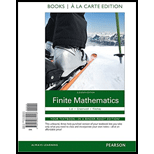
Concept explainers
Civil War Estimates of the Union Army's strength and losses for the battle of Gettysburg are given in the following table, where strength is the number of soldiers immediately preceding the battle and loss indicates a soldier who was killed, wounded, captured, or missing. Source: Regimental Strengths and Losses of Gettysburg.
| Unit | Strength | Loss |
| I Corps (Reynolds) | 12,222 | 6059 |
| II Corps (Hancock) | 11,347 | 4369 |
| III Corps (Sickles) | 10,675 | 4211 |
| V Corps (Sykes) | 10,907 | 2187 |
| VI Corps (Sedgwick) | 13,596 | 242 |
| XI Corps (Howard) | 9188 | 3801 |
| XII Corps (Slocum) | 9788 | 1082 |
| Cavalry (Pleasonton) | 11,851 | 610 |
| Artillery (Tyler) | 2376 | 242 |
| Total | 91,950 | 22,803 |
(a) Find the probability that a randomly selected Union soldier was from the XI Corps.
(b) Find the probability that a soldier was lost in the battle.
(e) Find the probability that a I Corps soldier was lost in the battle.
(d) Which group had the highest probability of not being lost in the battle?
(e) Which group had the highest probability of loss?
(f) Explain why these probabilities vary.
Want to see the full answer?
Check out a sample textbook solution
Chapter 7 Solutions
Finite Mathematics, Books a la Carte Plus MyLab Math Access Card Package (11th Edition)
- Please explain how come of X2(n).arrow_forwardNo chatgpt pls will upvotearrow_forwardFind all solutions of the polynomial congruence x²+4x+1 = 0 (mod 143). (The solutions of the congruence x² + 4x+1=0 (mod 11) are x = 3,4 (mod 11) and the solutions of the congruence x² +4x+1 = 0 (mod 13) are x = 2,7 (mod 13).)arrow_forward
- https://www.hawkeslearning.com/Statistics/dbs2/datasets.htmlarrow_forwardDetermine whether each function is an injection and determine whether each is a surjection.The notation Z_(n) refers to the set {0,1,2,...,n-1}. For example, Z_(4)={0,1,2,3}. f: Z_(6) -> Z_(6) defined by f(x)=x^(2)+4(mod6). g: Z_(5) -> Z_(5) defined by g(x)=x^(2)-11(mod5). h: Z*Z -> Z defined by h(x,y)=x+2y. j: R-{3} -> R defined by j(x)=(4x)/(x-3).arrow_forwardDetermine whether each function is an injection and determine whether each is a surjection.arrow_forward
- Let A = {a, b, c, d}, B = {a,b,c}, and C = {s, t, u,v}. Draw an arrow diagram of a function for each of the following descriptions. If no such function exists, briefly explain why. (a) A function f : AC whose range is the set C. (b) A function g: BC whose range is the set C. (c) A function g: BC that is injective. (d) A function j : A → C that is not bijective.arrow_forwardLet f:R->R be defined by f(x)=x^(3)+5.(a) Determine if f is injective. why?(b) Determine if f is surjective. why?(c) Based upon (a) and (b), is f bijective? why?arrow_forwardLet f:R->R be defined by f(x)=x^(3)+5.(a) Determine if f is injective.(b) Determine if f is surjective. (c) Based upon (a) and (b), is f bijective?arrow_forward
 Discrete Mathematics and Its Applications ( 8th I...MathISBN:9781259676512Author:Kenneth H RosenPublisher:McGraw-Hill Education
Discrete Mathematics and Its Applications ( 8th I...MathISBN:9781259676512Author:Kenneth H RosenPublisher:McGraw-Hill Education Mathematics for Elementary Teachers with Activiti...MathISBN:9780134392790Author:Beckmann, SybillaPublisher:PEARSON
Mathematics for Elementary Teachers with Activiti...MathISBN:9780134392790Author:Beckmann, SybillaPublisher:PEARSON
 Thinking Mathematically (7th Edition)MathISBN:9780134683713Author:Robert F. BlitzerPublisher:PEARSON
Thinking Mathematically (7th Edition)MathISBN:9780134683713Author:Robert F. BlitzerPublisher:PEARSON Discrete Mathematics With ApplicationsMathISBN:9781337694193Author:EPP, Susanna S.Publisher:Cengage Learning,
Discrete Mathematics With ApplicationsMathISBN:9781337694193Author:EPP, Susanna S.Publisher:Cengage Learning, Pathways To Math Literacy (looseleaf)MathISBN:9781259985607Author:David Sobecki Professor, Brian A. MercerPublisher:McGraw-Hill Education
Pathways To Math Literacy (looseleaf)MathISBN:9781259985607Author:David Sobecki Professor, Brian A. MercerPublisher:McGraw-Hill Education





